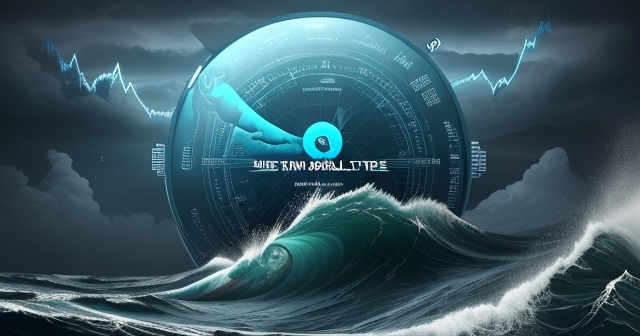Navigating Turbulent Waters: A Deep Dive into Index Trading Platforms Amidst Global Economic Shifts
The global financial markets are dynamic, often likened to a vast, ever-changing ocean. Currently, these waters feel particularly turbulent. You’ve likely witnessed the headlines: major stock indices experiencing significant selloffs, driven by palpable fears surrounding inflation and the looming specter of tariffs. For both new and experienced traders, understanding these powerful forces and knowing how to effectively navigate them is paramount. This requires not just market knowledge, but also access to the right tools – specifically, sophisticated index trading platforms.
In this comprehensive exploration, we will dissect the recent market turmoil, understand the root causes like inflation and tariffs, and most importantly, examine the critical role that trading platforms play in empowering you to participate in, analyze, and manage risk within these volatile index markets. Think of us as your seasoned guide, helping you chart a course through the complexities ahead.
Here are some key components that will impact your trading experience:
- Understanding the influences of inflation and tariffs on market volatility.
- The necessity of choosing the right trading platform for efficiency.
- Using analytical tools and resources effectively to enhance decision-making.

The Inflation Spectre: A Primary Catalyst for Market Jitters
Inflation is a term we hear frequently, but its real-world impact on asset prices, particularly stock indices, can be profound and swift. When the cost of goods and services rises persistently, it erodes the purchasing power of money. For businesses, this can mean higher input costs, which may squeeze profit margins if they can’t pass those costs onto consumers. For investors, it can signal that the returns from their investments might not keep pace with the rising cost of living.
Recent data, such as the Personal Consumption Expenditures (PCE) report, is closely watched by market participants and policymakers alike. Elevated or rising PCE figures, often seen as the Federal Reserve’s preferred inflation gauge, increase the likelihood that central banks, like the FOMC, will need to tighten monetary policy. This typically involves raising interest rates. Higher interest rates make borrowing more expensive for companies, potentially slowing growth. They also make fixed-income assets, like bonds, more attractive relative to stocks, drawing capital away from equities. This shift in investor preference and the prospect of slower economic activity are key reasons why inflation fears can trigger widespread selling across major indices like the S&P 500, Dow Jones Industrial Average (DJIA), and Nasdaq Composite.
Consider it like this: If you have a fixed amount of money, and everything becomes more expensive, the ‘value’ of your money decreases. Similarly, if a company’s earnings power is diminished by rising costs, the perceived ‘value’ of its stock might also decrease. This collective reassessment by millions of investors leads to downward pressure on the prices of the constituent stocks, and by extension, the indices they comprise. The market plunge driven by these fears is not theoretical; it’s a direct reaction to the economic realities and anticipated policy responses.

Tariffs: A Geopolitical Storm Brewing Over Financial Shores
Beyond inflation, another significant, often more unpredictable, factor currently shaking the markets is the imposition or threat of tariffs. Tariffs are taxes placed on imported goods or services. While intended to protect domestic industries, they can have far-reaching and often negative consequences for the global economy and financial markets.
When tariffs are enacted, they increase the cost of imported raw materials for businesses, similar to inflation, but often in a more targeted way. They also make exported goods more expensive for international buyers, potentially reducing sales volumes for companies that rely on foreign markets. Crucially, tariffs can trigger retaliatory measures from other countries, leading to trade wars. These trade disputes create immense uncertainty for businesses regarding supply chains, production costs, and market access.
The data we’ve seen highlights how figures like former President Trump’s tariff policies, particularly regarding sectors like automobiles, are directly linked to market ‘carnage’ and are perceived as potential disruptors of the global financial system. This isn’t just abstract policy; it translates into real financial outcomes. For instance, companies like Tesla and Apple, which have significant international operations and supply chains, can face price target cuts from analysts specifically due to the fallout from tariff disputes. This illustrates how macro-level political decisions have micro-level impacts that ripple through specific stocks and ultimately influence the performance of major indices like the Nasdaq, which has a heavy concentration of tech and global companies.
The market’s reaction to tariff fears is often characterized by sudden, sharp drops, as investors struggle to price in the unpredictable outcomes of political negotiations and trade conflicts. It’s a powerful reminder that financial markets are not isolated systems; they are deeply intertwined with geopolitical events and economic policies.

Major Indices Under Siege: Analyzing Performance and Volatility
The combined pressure from inflation fears and tariff threats has led to significant declines across the board in major US indices. We’ve observed substantial drops in the DJIA, S&P 500, and Nasdaq. The S&P 500, a benchmark often used to gauge the health of the broader US economy, was recently noted as being on pace for a significant negative streak, with some comparing the severity of the selloff to periods seen during historical market downturns like the 1987 crash. This highlights the magnitude of the current market stress.
Index futures, which are contracts to buy or sell an index at a specific future date and price, often move before the main market opens and can provide a strong indication of market sentiment. When Dow futures, for example, plunge over 1,000 points, as they have, it signals a widespread expectation of a bearish market open. This immediate reaction in futures markets demonstrates the forward-looking nature of financial markets and how quickly fear can propagate.
Volatility, often measured by indices like the VIX (Cboe Volatility Index), spikes during these periods of uncertainty and selling pressure. The VIX is often referred to as the market’s “fear gauge.” When the VIX rises significantly, it indicates that investors anticipate greater price swings in the S&P 500 over the near term. High volatility means that price movements, both up and down, can be large and rapid, increasing the potential for both significant gains and significant losses for traders.
Understanding the performance of these major indices – not just their current price, but their historical context and volatility levels – is fundamental for any trader. It tells us about the overall health of the market and the prevailing investor sentiment. Are investors in ‘risk-on’ or ‘risk-off’ mode? The recent movements strongly suggest the latter, with capital flowing out of equities as market participants seek safer havens or simply reduce exposure to risk.

The Bedrock of Trading: Exchanges as Market Infrastructure
Before we delve into how you can actively trade indices, it’s crucial to understand the underlying infrastructure that makes it all possible. At the heart of the financial ecosystem are the major exchanges, such as the Nasdaq and the New York Stock Exchange (NYSE). These institutions are far more than just physical trading floors (though they have historical roots there); they are sophisticated technology companies that serve as the primary marketplaces for buying and selling securities.
Exchanges provide essential functions:
- Listing: Companies list their stocks and other securities (like ETFs) on exchanges to raise capital from public investors. Nasdaq, for example, is well-known as a listing venue for tech and growth companies, while the NYSE lists a wide range of companies, including many large, established corporations.
- Trading Platform Provision: They offer the core technology platforms where buyers and sellers meet and execute trades. These platforms are designed for speed, efficiency, and transparency (though transparency varies by market segment).
- Market Data: Exchanges are primary sources of real-time market data, including prices, trading volumes, and order book information. This data is crucial for traders making informed decisions.
- Regulation and Oversight: While not the sole regulators, exchanges play a significant role in market integrity, setting rules for listing companies and member firms, and monitoring trading activity for compliance.
These exchanges are the engines driving price discovery for the countless securities that make up the indices we trade. Their infrastructure is the foundation upon which all other trading activities, including those conducted via brokerage platforms, are built. Understanding their role helps provide a more complete picture of how trades are processed and how markets function at a fundamental level.

Choosing Your Vessel: The Importance of a Robust Trading Platform
Given the complexity and volatility of index markets, selecting the right trading platform is not merely a matter of convenience; it is absolutely essential for success. A trading platform is your interface with the financial markets. It’s where you access data, perform analysis, place trades, and manage your positions. Think of it as the cockpit of your trading journey – you need reliable controls and clear information displays, especially when flying through a storm.
Brokerage firms offer various types of platforms tailored to different needs and asset classes, including platforms specifically designed for trading indices. These platforms can provide access to major global indices like the S&P 500, Nasdaq 100, DJIA, FTSE 100, Germany 40 (DAX), Australia 200 (ASX), and many others. The quality and features of these platforms vary significantly, and choosing wisely can dramatically impact your trading experience and potential outcomes.
A good index trading platform should offer:
- Access to a wide range of global indices.
- Real-time, reliable market data (prices, charts, news feeds).
- Advanced charting tools with various technical indicators.
- Efficient order execution with minimal slippage.
- Risk management tools (stop-loss orders, take-profit orders).
- Educational resources and analytical tools.
- Responsive customer support.
The platform is where market theory meets practical application. It’s where you translate your analysis of inflation, tariffs, and index performance into actionable trades. Without a capable platform, even the best market insights can be difficult to capitalize on.
If you’re looking to trade indices or explore a wide variety of CFD instruments, evaluating potential platforms is a crucial step. Consider what features are most important for your trading style and goals.
| Feature | Importance |
|---|---|
| Access to Global Indices | Essential for diverse trading strategies. |
| Real-time Market Data | Crucial for informed decision-making. |
| Risk Management Tools | Helps protect capital against market fluctuations. |
Mechanics of Index Trading: CFDs, Leverage, and Risk Management
One common and flexible way to trade indices is through Contracts for Difference (CFDs). A CFD is a derivative contract that allows you to speculate on the price movement of an underlying asset, such as a stock index, without actually owning the asset itself. When you trade index CFDs, you are entering into a contract with a broker to exchange the difference in the price of the index from the time the contract is opened until it is closed.
CFD trading offers several key features relevant to index trading:
- Go Long or Short: You can profit from both rising (going long) and falling (going short) index prices. In volatile markets like the current one driven by tariff and inflation fears, the ability to potentially profit from downward movements is a valuable tool.
- Leverage: CFDs typically allow you to trade with leverage. Leverage means you only need to put down a small percentage of the total trade value as margin to control a much larger position. While this magnifies potential profits, it also significantly magnifies potential losses. Understanding and managing leverage is critical.
- Accessibility: CFDs often provide access to a wide array of global indices and can be traded outside standard exchange hours, sometimes offering 24/7 access or weekend trading on specific markets.
- Liquidity: Major index CFDs are generally very liquid, meaning you can typically enter and exit trades quickly and efficiently at competitive prices (spreads).
However, the leveraged nature of CFDs makes risk management non-negotiable. Placing stop-loss orders to automatically close a trade if the price moves against you by a certain amount is a fundamental practice. Understanding margin requirements and avoiding over-leveraging your account are also essential for protecting your capital, especially during periods of high volatility like those triggered by inflation and tariff news.
If you’re considering starting index trading or exploring more CFD products, finding a platform that supports these features effectively and provides robust risk management tools is key. It’s important to remember that trading leveraged products carries a high level of risk and may not be suitable for everyone.

Connecting the Dots: Macro Events and Index Performance
One of the most fascinating aspects of financial markets, particularly indices, is how seemingly disparate macro events converge to influence prices. We’ve discussed inflation data (PCE) and tariff announcements as primary drivers of recent index declines. But many other factors contribute to the overall market narrative and index movements.
- Central Bank Policy: Decisions made by the FOMC regarding interest rates and quantitative easing/tightening directly impact borrowing costs, corporate profitability, and investor risk appetite, thereby influencing indices.
- Economic Indicators: Reports on GDP growth, unemployment rates, manufacturing activity, retail sales, and consumer confidence paint a picture of the economy’s health, which is strongly reflected in index performance. Signs of a potential recession, for instance, often lead to significant index selloffs.
- Geopolitical Events: Political instability, international conflicts, or significant policy shifts beyond tariffs can introduce uncertainty and risk premiums into asset prices.
- Corporate Earnings: While index movements reflect the aggregate performance of many companies, collective earnings reports from major index constituents can significantly move the index, especially during earnings seasons.
A good trading platform provides access to calendars and news feeds that track these macro events in real time. By observing how indices react to specific data releases or policy announcements, you can gain insights into market sentiment and potentially anticipate future price movements. For example, a strong jobs report might boost indices on hopes of economic growth, while a surprisingly high inflation print could trigger selling on fears of aggressive rate hikes.
Developing the skill to connect these macro dots – understanding *why* the market is moving – is a crucial part of becoming a proficient trader. It moves you beyond simply watching price charts to understanding the underlying forces at play.
The Micro Within the Macro: Company News and Sector Impacts
While indices represent the broader market or specific sectors, they are ultimately composed of individual companies. News and performance at the micro-level can also influence index movements, especially for indices heavily weighted towards certain large companies or sectors.
Consider the examples from the provided data:
- Tesla and Apple Price Target Cuts: When major companies like these face challenges, whether due to tariff fallout, supply chain issues, or competitive pressures, analyst downgrades or news of slowing growth can cause their stock prices to fall. Given their significant weighting in indices like the Nasdaq 100 and S&P 500, declines in such stocks can have a noticeable impact on the overall index performance.
- IPO Activity: The success or struggles of Initial Public Offerings (IPOs), like the mention of CoreWeave’s IPO debut reflecting market skepticism, can serve as a barometer for investor appetite for risk and growth stocks. A cautious market reaction to new listings can contribute to a broader negative sentiment that affects indices.
- Sector-Specific News: Performance trends in sectors like technology, casual dining, or life sciences, driven by innovation, consumer demand, or regulatory changes, will specifically influence sector-specific indices or broader indices with significant exposure to those sectors.
Trading platforms provide tools that allow you to drill down from the index level to the performance of its constituent stocks. You can often view the top movers within an index, track news related to specific companies, and analyze sector performance. This allows you to understand which components are driving the overall index movement and whether the strength or weakness is broad-based or concentrated in a few areas.
Integrating this micro-level analysis with macro-level insights provides a more nuanced view of the market. Is the S&P 500 falling because of systemic, macro fears (inflation, tariffs), or is it being dragged down by issues specific to one or two heavily weighted stocks or sectors? A capable trading platform helps you answer these questions.
Executing Your Strategy: Orders, Spreads, and Execution Speed
Once you have analyzed the market, identified potential trading opportunities based on your insights into inflation, tariffs, index performance, and company news, the next step is execution. This is where the technical capabilities of your trading platform become paramount. How quickly and efficiently can the platform place your orders? What are the costs involved (spreads and commissions)?
Key execution factors to consider:
- Order Types: Beyond simple market orders (buy/sell immediately at the best available price), platforms offer various order types crucial for managing risk and specifying entry/exit points. Limit orders allow you to set a specific price at which you want to buy or sell. Stop-loss orders are essential for automatically closing a losing position at a predetermined price. Take-profit orders close a winning position when it reaches a target price.
- Spreads: The spread is the difference between the buy (ask) price and the sell (bid) price of an index CFD. It is essentially the cost of executing the trade. Platforms with tight spreads can reduce trading costs, which is particularly important for frequent traders.
- Execution Speed: In volatile markets, prices can change rapidly. High-speed order execution is vital to ensure your orders are filled at or near the price you intended, minimizing slippage (the difference between the expected price of a trade and the price at which the trade is actually executed).
- Liquidity and Depth: A platform connected to markets with good liquidity ensures that you can execute large orders without significantly impacting the price.
The infrastructure provided by exchanges like Nasdaq and NYSE, coupled with the technology offered by brokerage platforms like IG or others mentioned in the data, work together to facilitate this execution. Understanding how orders are processed and the factors that influence execution quality is key to effective trading, especially when attempting to capture opportunities or manage risks in fast-moving index markets reacting to major economic news.
Risk Management in Volatile Markets: Tools and Techniques
We’ve emphasized the current market volatility driven by inflation and tariffs. This environment significantly heightens the importance of robust risk management. Trading indices, especially with leverage via CFDs, exposes you to substantial risk. A good trading platform provides tools to help you mitigate this risk.
- Stop-Loss Orders: As mentioned, these are your primary defense against large losses. Setting a stop-loss on every trade is a fundamental practice that protects your capital if the market moves sharply against your position.
- Take-Profit Orders: These help lock in gains. By setting a target price, you ensure that you exit a winning trade automatically, preventing it from turning into a losing one if the market reverses.
- Leverage Control: Platforms should allow you to easily see and manage your margin usage. Avoid using excessive leverage, especially as a beginner, as it can quickly lead to margin calls and account liquidation during sudden market swings.
- Position Sizing: A key risk management technique involves determining the appropriate size of your trade based on your total capital and your risk tolerance. A platform might offer tools or calculators to assist with this.
- Negative Balance Protection: Some platforms offer negative balance protection, ensuring you cannot lose more money than you have deposited in your account. This is a crucial feature, particularly with leveraged trading.
Beyond the platform’s technical tools, your own discipline is the most critical factor in risk management. Define your risk tolerance *before* entering a trade. Never risk more capital on a single trade than you can afford to lose. Volatility means potential rewards are higher, but so are the risks. Approaching the market with a well-defined risk management strategy, supported by your platform’s capabilities, is paramount.
If you are looking for a brokerage that provides regulatory protection and enables global trading, Moneta Markets holds multiple international licenses, including FSCA, ASIC, and FSA. They also offer segregated client funds, free VPS, and 24/7 multilingual customer support, making them a popular choice for many traders seeking comprehensive support and security.
Beyond Trading: Platform Features for Analysis and Education
A truly valuable trading platform offers more than just execution capabilities; it serves as a hub for analysis, information, and education. To effectively trade indices impacted by complex factors like inflation, tariffs, and global events, you need tools to help you understand the market landscape.
- Charting Tools: We touched on this, but advanced charting with a wide array of technical indicators (Moving Averages, RSI, MACD, etc.) is essential for technical analysis. The ability to customize charts, draw trendlines, and identify patterns is fundamental.
- News and Research Feeds: Integrated news feeds (potentially from sources like CNBC, MarketWatch) and research reports provide timely information on economic data releases, corporate news, and analyst opinions – precisely the information driving those index movements.
- Economic Calendars: Tracking upcoming economic events (like FOMC meetings, PCE releases, jobs reports) and geopolitical announcements is crucial for anticipating potential volatility. A built-in economic calendar is highly useful.
- Educational Resources: Many platforms offer tutorials, webinars, articles, or demo accounts to help users learn about trading, technical analysis, risk management, and specific markets like index trading. This is invaluable for beginners and experienced traders looking to refine their skills.
- Analytical Tools: Some platforms provide unique analytical tools, market sentiment indicators, or screening capabilities that can help you identify potential trading opportunities or assess the overall market mood.
The best platforms empower you to not just trade, but to learn and grow as a trader. By providing access to robust analytical tools and educational content, they help you build the knowledge base needed to interpret complex market signals, whether they come from inflation data, tariff headlines, or corporate earnings reports. Your platform should be a partner in your continuous learning journey.
Conclusion: Equipping Yourself for the Volatile Index Market
The current financial market environment, characterized by pronounced volatility stemming from inflation fears and tariff uncertainty, underscores a timeless truth: success in trading is a confluence of knowledge, strategy, and the right tools. Indices, as barometers of broader market sentiment and economic health, react powerfully to these macroeconomic and geopolitical forces. Understanding the ‘why’ behind these movements is crucial for making informed trading decisions.
We have explored how inflation erodes purchasing power and prompts central bank action, how tariffs disrupt global trade and introduce unpredictable risk, and how these factors manifest as significant selloffs and increased volatility in major indices like the S&P 500, Nasdaq, and DJIA. We’ve also seen how these macro forces connect to micro-level impacts on individual companies and sectors.
Navigating this landscape requires more than just intuition. It demands access to reliable market data, sophisticated analytical capabilities, efficient execution, and robust risk management tools. This is precisely where modern index trading platforms, built upon the infrastructure of exchanges like Nasdaq and NYSE and offered by various brokers, prove indispensable. They are your gateway to the market, providing the information and functionality you need to interpret the signals, plan your trades (whether going long or short), manage leverage, and protect your capital.
As you embark on or continue your trading journey, especially in the potentially rewarding yet inherently risky world of index trading, remember the importance of continuous learning, disciplined risk management, and leveraging the capabilities of a platform that aligns with your needs. The turbulent waters may persist, but with the right knowledge and tools, you can equip yourself to navigate them more confidently and potentially achieve your trading goals.
index trading platformFAQ
Q:What is an index trading platform?
A:An index trading platform is a software application that allows traders to buy and sell financial indices, providing tools and resources to analyze market conditions and execute trades.
Q:How do I choose the right index trading platform?
A:Consider factors such as access to the desired indices, quality of market data, risk management tools, ease of use, and educational resources provided by the platform.
Q:What are the risks associated with index trading?
A:Risks include market volatility, leverage risks, and the possibility of losses if market movements are against your trades. Effective risk management strategies are crucial.

留言